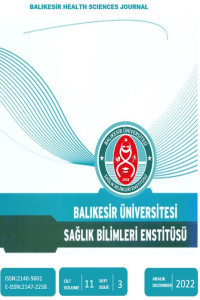Prostat Kanserinde Bakır, Berilyum, Bor, Titanyum ve Vanadyum İyonlarının Prognostik Önemi Var mı?
Is There A Prognostic Significance For Copper, Beryllium, Boron, Titanium and Vanadium Ions in Prostate Cancer?
prostate cancer, metal, non-metal, ICP-MS,
___
- 1- Crawford, E. David. Epidemiology of prostate cancer. Urology, 2003; 62(6): 3-12.
- 2- Rebbeck, Timothy R. Conquering cancer disparities: new opportunities for cancer epidemiology, biomarker, and prevention research. 2006; 15(9): 1569–1571.
- 3- Crawford, E. David, et al. An approach using PSA levels of 1.5 ng/mL as the cutoff for prostate cancer screening in primary care. Urology, 2016; 96: 116-120.
- 4- Kumar, Vinay; Abbas, Abul K.; Aster, Jon C. Robbins basic pathology e-book. Elsevier Health Sciences, 2017.
- 5- Spitz, Margaret R., et al. Epidemiologic determinants of clinically relevant prostate cancer. International journal of cancer, 2000; 89(3): 259-264.
- 6- Sarafanov, Andrey G., et al. Prostate cancer outcome and tissue levels of metal ions. The Prostate, 2011; 71(11): 1231-1238.
- 7- Neslund-Dudas, Christine, et al. Prostate tissue metal levels and prostate cancer recurrence in smokers. Biological trace element research, 2014; 157(2): 107-112.
- 8- Çelen, İlker, et al. Selenium, nickel, and calcium levels in cancerous and non-cancerous prostate tissue samples and their relation with some parameters. Environmental Science and Pollution Research, 2015;22(17): 13070-13076.
- 9- Falkeholm, Lars, et al. Xylene-free method for histological preparation: a multicentre evaluation. Laboratory investigation, 2001; 81(9): 1213-1221.
- 10- Gumulec, Jaromir, et al. Serum and tissue zinc in epithelial malignancies: a meta-analysis. PLoS One, 2014;, 9(6): e99790.
- 11- Zaichick, Vladimir; Nosenko, Sergey; Moskvina, Irina. The effect of age on 12 chemical element contents in the intact prostate of adult men investigated by inductively coupled plasma atomic emission spectrometry. Biological trace element research, 2012; 147(1-3): 49-58.
- 12- Zaichick, V. Ye; Sviridova, T. V.; Zaichick, S. V. Zinc in the human prostate gland: normal, hyperplastic and cancerous. International urology and nephrology, 1997; 29(5): 565-574.
- 13- LI, Xiao‐Meng, et al. Measurement of serum zinc improves prostate cancer detection efficiency in patients with PSA levels between 4 ng/mL and 10 ng/mL. Asian journal of andrology, 2005; 7(3): 323-328.
- 14- Leitzmann, Michael F., et al. Zinc supplement use and risk of prostate cancer. Journal of the National Cancer Institute, 2003; 95(13): 1004-1007.
- 15- Yaman, Mehmet, et al. Comparison of trace metal concentrations in malign and benign human prostate. Journal of medicinal chemistry, 2005; 48(2): 630-634.
- 16- Singh, Bhupendra Pal, et al. Status and interrelationship of zinc, copper, iron, calcium and selenium in prostate cancer. Indian Journal of Clinical Biochemistry, 2016; 31(1): 50-56.
- 17- Bulka, Catherine M., et al. Arsenic in drinking water and prostate cancer in Illinois counties: An ecologic study. Environmental research, 2016; 148: 450-456.
- 18- Silvera, Stephanie A. Navarro; Rohan, Thomas E. Trace elements and cancer risk: a review of the epidemiologic evidence. Cancer Causes & Control, 2007; 18(1): 7-27.
- 19- Benbrahim-Tallaa, Lamia; Waalkes, Michael P. Inorganic arsenic and human prostate cancer. Environmental health perspectives, 2008; 116(2): 158-164.
- 20- D. R. Intakes, U. Vanadium, Z. R. Levels, D. R. Intakes, S. Committee, S. Evaluation, D. Reference, I. Isbn, T. Pdf, N. A. Press, N. A. Press, N. Academy, N. Academy, and N. A. Press, Dietary Reference Intakes. 2000.
- 21- Boyacioglu, Seda Orenay, et al. Biological effects of tolerable level chronic boron intake on transcription factors. Journal of Trace Elements in Medicine and Biology, 2017; 39: 30-35.
- 22- Cui, Y., Winton, M. I., Zhang, et al. Dietary boron intake and prostate cancer risk. Oncology reports,2004; 11(4): 887-892.
- 23- Boffetta, Paolo; Fryzek, Jon P.; Mandel, Jack S. Occupational exposure to beryllium and cancer risk: a review of the epidemiologic evidence. Critical reviews in toxicology, 2012; 42(2): 107-118.
- 24- Sanderson, Wayne T., et al. Lung cancer case–control study of beryllium workers. American journal of industrial medicine, 2001; 39(2): 133-144.
- 25- Rooney, Cleone, et al. Case-control study of prostatic cancer in employees of the United Kingdom Atomic Energy Authority. British Medical Journal, 1993; 307(6916): 1391-1397.
- 26- Visuri, Tuomo, et al. Decreased cancer risk in patients who have been operated on with total hip and knee arthroplasty for primary osteoarthrosis: a meta-analysis of 6 Nordic cohorts with 73,000 patients. Acta orthopaedica Scandinavica, 2003; 74(3): 351-360.
- 27- Visuri, Tuomo, et al. Cancer risk is not increased after conventional hip arthroplasty: a nationwide study from the Finnish Arthroplasty Register with follow-up of 24,636 patients for a mean of 13 years. Acta orthopaedica, 2010; 81(1) 77-81.
- ISSN: 2146-9601
- Yayın Aralığı: Yılda 3 Sayı
- Başlangıç: 2012
- Yayıncı: Balıkesir Üniversitesi
Merhamet Ölçeğinin Kısa Formunun Türkçe Geçerlik Güvenirlik Çalışması
Şengül ÜZEN CURA, Nurtekin CURA
Seyhan ÇANKAYA, Cevriye OCAKTAN
İnternetteki Sağlık Bilgileri Güvenilir Mi? Evde Ateş Yönetimi ile İlgili Bir Çalışma
Gülçin KORKMAZ YENİCE, Figen Işık ESENAY
Onur ARGAN, Serdar BOZYEL, Kadriye AKAY, Eyüp AVCI, Tuncay KIRIŞ
Kadınların Özel Hastanede Doğum Yapma Tercihi ve Doğum Deneyimleri: Nitel Araştırma
Ummahan YÜCEL, Bihter AKIN, Kübra GÜZEL
Benlik Saygısının Hemşirelerin Mutluluk, Yaşam Doyumu ve Umutsuzluk Düzeylerine Yordayıcı Etkisi
Nurgül ÖZDEMİR, Burçin IŞIK, Burcu ÇAKI
Fertilite Sağlığı Bilgi Ölçeği’nin Türkçeye Uyarlanması: Geçerlik ve Güvenirlik Çalışması
Sıçanlarda İndometazin ile İndüklenen Mide Ülseri Üzerine Badem ve Elma Yağının Koruyucu Etkileri
Özlem AYDIN BERKTAŞ, Fadime ATALAY DUMLU
Merve YUMRUKUZ ŞENEL, Serap DURU, Bahar KURT
Serap KAYNAK, Yasemin YILDIRIM, Zehra Çiçek FADILOĞLU, Fisun ŞENUZUN AYKAR
